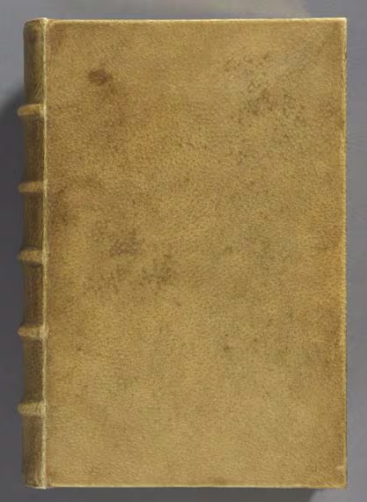哈佛大学去除了 19 世纪书籍装订中使用的人皮

【中美创新时报2024 年 3 月 28 日讯】(记者温友平编译)哈佛大学图书馆官员表示,他们已经从该大学收藏的一本 19 世纪书籍的装订中去除了人皮,并正在探索“尊重”的方式来安息遗骸。《波士顿环球报》记者尼克·斯托伊科(Nick Stoico) 对此作了下述报道。
该书的原主人、1933 年去世的法国医生卢多维奇·博兰德(Ludovic Bouland )医生从他工作的医院里取了一名已故女性精神病患者的皮肤,并用它装订了阿尔塞纳·侯赛(Arsène Houssaye )的书《Des destinées de l’âme》。”这可以追溯到 1880 年代,哈佛大学官员在周三的一份声明中表示。
官员们表示,从该卷中去除皮肤的决定是根据哈佛委员会 2022 年报告中的建议做出的,该委员会负责考虑在博物馆和图书馆保存人类遗骸的道德规范。
“这本书创作的核心问题是,一名医生没有看到自己面前的一个完整的人,就做出了一种令人厌恶的行为,几乎可以肯定是在未经同意的情况下,从已故患者身上摘下了一块皮肤,并将其用于医疗用途。一个多世纪以来,许多人都在处理书籍装订,”负责档案和特殊馆藏的大学图书馆副馆长汤姆·海里(Tom Hyry)在该大学随声明一起发表的问答中说道。 “我们相信现在是安息遗体的时候了。”
自去年夏天以来,哈佛一直面临争议,当时当局指控哈佛医学院太平间经理盗窃和出售从尸体上取下的身体部位。
这本书自 1934 年起就被哈佛收藏,但该校直到 80 年后才确认它是用人皮装订的。该大学于 2014 年在两篇博文中宣布了这一发现,并得到了媒体的广泛报道。
周三,图书馆官员表示,这些帖子轻视了这一发现,并且以“耸人听闻、病态和幽默的语气”撰写。
哈佛图书馆在一份声明中表示,“哈佛图书馆承认过去在管理这本书方面的失败,进一步物化和损害了被用于装订遗体的人的尊严。” “我们向那些受到这些行为不利影响的人致歉。”
哈佛大学委员会的 2022 年报告重点关注了该校收藏的使用奴隶和美洲原住民皮肤的书籍,但它也提到了《Des destinées de l’âme》一卷。该图书馆成立了一个工作组来研究这本书的历史,并分析“有关用人体皮肤装订书籍的现有文献”,该工作组主席海里说。
“审查证实,我们可以合理确定博兰德在未经同意的情况下移除并使用了皮肤,”他说。
官员们称,美国外交官、哈佛大学毕业生约翰·斯泰森 (John Stetson) 于 1934 年将这本书存放在哈佛大学,20 年后,他的遗孀鲁比·斯泰森 (Ruby Stetson) 将其捐赠给了哈佛大学。在随书附赠的一份备忘录中,斯泰森写道,博兰德从一位身份不明的女性身上取下了皮肤,她曾是法国一家精神病医院的病人。
海里说,侯赛的书是“对灵魂和死后生命的沉思”。博兰德在书中插入的注释写道:“一本关于人类灵魂的书应该有一个人类的封面。”
官员们表示,图书馆用户可以通过哈佛图书馆在线阅读这本书,但目前无法亲自阅读。
霍顿图书馆副馆长安妮-玛丽·埃兹在一份声明中表示,遗骸目前被保存在哈佛图书馆的“安全储藏室”中,官员们正在决定下一步该做什么。
埃兹说:“图书馆正在与大学和法国的有关当局协商,以确定以适当且尊重的方式安葬遗骸。”
题图:哈佛大学图书馆官员表示,他们已经从该大学收藏的一本 19 世纪书籍的装订中去掉了人皮。 该大学于 2014 年宣布发现了这本书。HOUGHTON LIBRARY, HARVARD UNIVERSITY / HANDOUT/EPA
附原英文报道:
Harvard University removes human skin used in binding of 19th-century book
By Nick Stoico Globe Staff,Updated March 28, 2024
Harvard University library officials say they have removed human skin from the binding of a 19th-century book in the university’s collection and are exploring “respectful” ways to lay the remains to rest.
The book’s original owner, French physician Dr. Ludovic Bouland, who died in 1933, took the skin from a deceased female psychiatric patient at a hospital where he worked and used it to bind a copy of Arsène Houssaye’s book “Des destinées de l’âme,” which dates to the 1880s, Harvard officials said in a statement on Wednesday.
Officials said the decision to remove the skin from the volume was prompted by recommendations in a 2022 report by a Harvard committee charged with considering the ethics of having human remains in its museums and libraries.
“The core problem with the volume’s creation was a doctor who didn’t see a whole person in front of him and carried out an odious act of removing a piece of skin from a deceased patient, almost certainly without consent, and used it in a book binding that has been handled by many for more than a century,” Tom Hyry, associate university librarian for archives and special collections said in a Q&A the university published with its statement. “We believe it’s time the remains be put to rest.”
Harvard has faced controversy since last summer when authorities charged the morgue manager at Harvard Medical School with stealing and selling body parts taken from cadavers.
The book has been in Harvard’s collection since 1934, but the university didn’t confirm it was bound in human skin until 80 years later. The university announced the discovery in 2014 in a pair of blog posts, which received wide media coverage.
On Wednesday, library officials said those posts made light of the discovery and were written in a “sensationalistic, morbid, and humorous tone.”
“Harvard Library acknowledges past failures in its stewardship of the book that further objectified and compromised the dignity of the human being whose remains were used for its binding,” the university said in a statement. “We apologize to those adversely affected by these actions.”
The Harvard committee’s 2022 report focused on books that used the skin of enslaved people and Native Americans held in the university’s collection, but it also noted the volume of “Des destinées de l’âme.” The library created a task force to study the book’s history and analyze “the extant literature regarding the practice of binding books in human skin,” said Hyry, who chaired the task force.
“The review confirmed that we can have reasonable certainty that Bouland removed and utilized the skin without consent,” he said.
John Stetson, an American diplomat and Harvard graduate, deposited the book at Harvard in 1934, and his widow, Ruby Stetson, donated it to the university 20 years later, officials said. In a memo accompanying the book, Stetson wrote that Bouland took the skin from an unknown woman who had been a patient at a French psychiatric hospital.
Houssaye’s book is a “meditation on the soul and life after death,” Hyry said. A note written by Bouland inserted in the book says, “A book about the human soul deserved to have a human covering.”
Officials said library users can read the book online through the Harvard Library, but it is currently unavailable in person.
Anne-Marie Eze, associate librarian of Houghton Library, said in a statement that the remains are being held in “secure storage” at Harvard Library as officials determine what to do next.
“The library is consulting with appropriate authorities at the University and in France to determine an appropriate and respectful way of laying the remains to rest,” Eze said.

